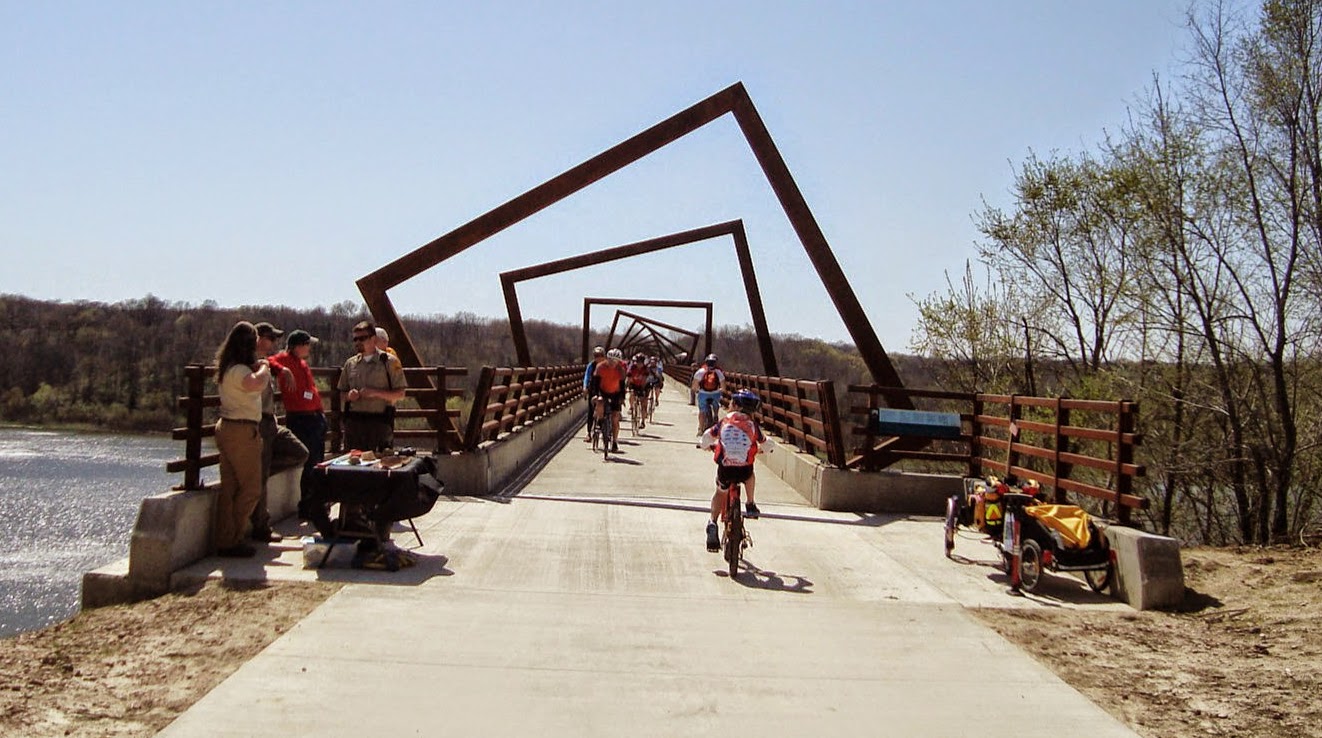 High Trestle Trail covering 25 miles is very popular with bicyclists. Photo by Iowa Natural Heritage Foundatio
High Trestle Trail covering 25 miles is very popular with bicyclists. Photo by Iowa Natural Heritage Foundatio
Which of these items create more long-term jobs, bike racks or bridges? The answer seems obvious, doesn't it? Or does it?
According to a recent study by the National Recreation and Parks Association, you might be surprised the economic impact that can result from improvements in bicycle and pedestrian infrastructure.
Cities across the country are finding this out. Why add more roads and bridges? When you think about it, adding more highways also creates more ways for people to pass through a city.
But when you fix up an area by adding more bike racks, bike paths, pedestrian walkways, pedestrian malls, etc., you are actually creating a way for people to spend more time in a city. You create a destination.
The NRPA facts bear this out. They determined:
- Bicycle Infrastructure Only projects generate 11.4 permanent jobs per $1 million spent.
- Pedestrian Infrastructure Only projects generate 9.9 permanent jobs per $1 million spent.
- Off-Street Multi-use Trail projects generate 9.57 permanent jobs per $1 million spent.
When it comes to Road Infrastructure Only projects, the amount of long-term jobs created were the lowest of the four - 7.75 jobs per million. You might spend millions on a bridge, but does it just relieve traffic instead of actually creating long-term jobs?
The reason for this is very obvious. People want to bike and walk. They prefer what the NRPA calls "active modes of transportation."
These active modes of transportation have benefits in four major areas of concern: health, economy, the environment and transportation accessibility.
The problem is, the US has become so dependent on cars for transportation and made so many accommodations for cars, that biking and walking are not always safe or attractive activities for people. People are scared to death to ride their bikes in town. There aren't many areas in many towns and cities that are worth walking to.
Case studies on the benefits of bike racks and bike paths
But savvy city planners are recognizing the benefits of creating better bike and pedestrian infrastructure. For example, once the city of West Palm Beach was having a difficult time. Many of the stores were closed. Street crime was increasing.
The mayor worked to revitalize the area by focusing on non-motorized transportation modes - adding bike racks, safer pedestrian crossings, traffic calming strategies, attractive open spaces, walkways by the river.
The result - downtown West Palm Beach is now the place to go for fun and activities. It's a people-friendly destination and not so much a car-friendly pass through (although they do provide plenty of parking garages. Which are much better than parking in limited metered spots. Even so, the garages entice people to visit the area, park their cars and walk around town).
Crime dropped, property values grew and building occupancy went up 80%!
In Iowa, a 25-mile bike trail was built on an old Union Pacific Railroad line that runs through several towns and counties. Called the "High Trestle Trail," it is now visited by more than 91,000 people a year. Local businesses near the trail report huge leaps in revenue.
At the Northern Outer Banks in North Carolina, $6.7 million was spent for constructing bicycle paths, purchasing bike racks and adding other bicycling amenities. The result? The North Carolina Department of Transportation reports nearly 680,000 tourists travel annually to the area, many to ride their bikes. That translates to approximately $60 million annually in economic activity.
The benefits are more than monetary. Health is a major concern. Obesity rates are climbing. In this electronic era, kids spend more time on a virtual football field than playing in an actual field.
Same with the environment. We don't need more people driving more often. According to the NRPA study, 50% of trips taken in the US could be done by riding a bicycle for 20 minutes. Just 20 minutes. In American cities, 28% of trips are less than a mile. Yet 60% of these trips are done by car.
When you add up all the Americans driving every day, think of all the carbon emissions that bicycle power could replace for these short trips. And, going back to health benefits, think how healthy that would be. Researchers say just 20 minutes of exercise per day can extend someone's life by three years.
Hey, ask any person if we need more automobiles on the road. The answer would be a resounding NO. Then ask them if it would be better for Americans if there were ways more people could bicycle or walk to stores, parks and work. The answer would be a resounding YES!
Bridges versus bike racks? The NRPA research clearly shows, bike racks, walkways and other improvements in bicycle and pedestrian infrastructure is actually the way to go.


